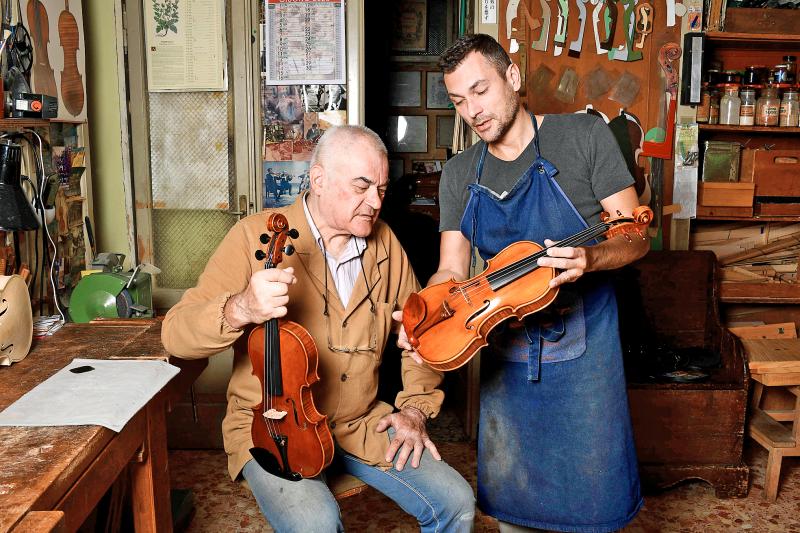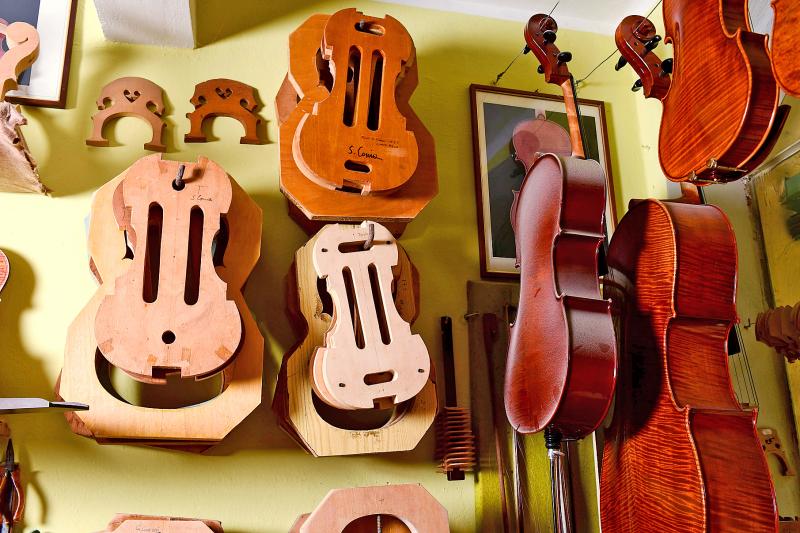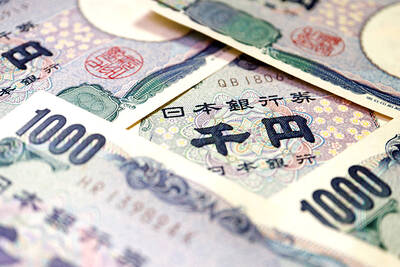Working in the shadow of the great masters, the violinmakers of Italy’s Cremona are valiantly fighting a shrinking market and foreign competition as they seek perfection, one violin at a time.
The birthplace of Stradivarius, Cremona is a veritable laboratory for luthiers from all over the world, where violin workshops seem to be everywhere you look.
Stefano Conia’s studio — just one of the 160 in the northern Italian city of 70,000 inhabitants — has not changed for decades.

Photo: AFP
It is situated at the back of a flower-filled courtyard, and this native Hungarian, one of the doyens of Cremonese violinmakers, heads there every day, despite retiring nearly 10 years ago.
“If I stopped making violins, life for me would be over. Every day I’m here in the workshop. It’s an antidote to old age,” said a smiling Conia, 74, whose father crafted violins and whose son is also pursuing the family tradition.
Conia’s workbench faces that of his son’s. Both are covered with files, clamps, compasses, brushes and small saws. Wooden planks are laid on the floor.

Photo: AFP
“Going into violin-making was a natural choice,” said Conia’s son, Stefano, known as “the youngster” who began handling tools at the age of seven or eight.
He spent his childhood in the workshop his father opened in 1972, two months before his birth.
“I would play with the wood and the musicians would come and buy their violins and play,” said the younger Conia. “It’s always been a special atmosphere, which I really liked.”
For the Conias, the violins lovingly made from flamed maple or spruce are more than just instruments — they become family.
“The instruments are a bit like children. They live thanks to the energy we give them, it is a part of us that will continue to live after our death,” Stefano Conia said.
Like the Conias, the majority of Cremona’s luthiers are foreigners. Many came to study at the Cremona International Violin Making School and stayed on.
“The school was started in 1938, the first teachers were foreigners and the students come from all over the world. There is a saying that ‘Nobody is a prophet in his own country’ and it’s true that we, Cremonese violinmakers, are really few and far between,” said Marco Nolli, 55, one of this exclusive club.
Of the one-third of Cremona’s violinmakers who are Italian, only about 10 percent come from Cremona, he said.
Benedicte Friedmann, a 45-year-old from France, has been living in “the cradle of violin-making” for about 20 years. “Coming to Cremona was — and maybe it’s a bit pretentious to say this — like walking in the footsteps of the greatest, Stradivarius, Guarneri, Amati,” she said, referring to the city’s most revered craftsmen of centuries past.
“Being a luthier here means being able to devote yourself 100 percent to creating instruments, and the more you do, the better you become,” Friedmann said.
In France, to earn a living as a violinmaker, many people do repairs, re-hair bows or sell accessories, which leaves them little time for their art, she said.
However, the situation is not always simple for the violinmakers of Cremona, who enjoyed growth in the 1960s-1980s, before things got tougher.
“Our market, which is an elite market, has shrunk. We are facing a very serious problem,” said Giorgio Grisales, president of the artisans’ consortium.
Fewer performances and musical venues and the preference of seasoned violinists for antique instruments from the 18th and 19th centuries have hurt the niche industry. Even before COVID-19 swept through northern Italy, Grisales said that “the sector was in trouble because of ruthless competition from China and Eastern Europe.”
China is the world’s leading producer of bowed instruments with US$77.8 million in exports last year, or 1.5 million instruments, more than half of the world market, according to the International Trade Centre.
Italy is in fifth position, with 4.6 percent of world exports, behind the UK and Germany, but ahead of France. Italy’s main customers are Japan and the US.
Italian violinmakers must contend with counterfeit instruments in the marketplace, some built elsewhere and advertised as Cremonese, but above all competition comes from lower priced violins. Master instruments start at 25,000 euros (US$27,943), although others of fine quality can sell for about 10,000 euros less, Grisales said.
However, for 200 euros or less, it is possible to buy a Chinese violin, bow and case.
“They are economic instruments, made in series, and intended for those who are beginning to study,” baroque violinist Fabrizio Longo said.
Friedmann, the French violinmaker, said that the process of making a violin in China is for the most part vastly different from the craftsmanship she and others in Cremona engage in.
“They are handmade, but 10 violinmakers work every day on the same parts. It’s a line job and at the end you get an assembly,” she said. “There’s no uniqueness, no authenticity.”
In Cremona, Grisales said that it takes at least 300 hours to make a violin, or between two to three months.
Another challenge for the luthiers is to stand out among the Cremonese competition.
“Getting known is a bit laborious,” while the search for orders “is a permanent quest,” Friedmann said.
Some violinmakers have been able to offer lower prices — hurting fellow luthiers — by working on the black market and avoiding high taxes.
Despite these challenges, Friedmann said that the concentration of violinmakers in Cremona creates a healthy environment of emulation and the desire to excel.
“When I’m asked which is the most beautiful instrument I’ve made, for me it’s always the next one,” she said.

AI TALENT: No financial details were released about the deal, in which top Groq executives, including its CEO, would join Nvidia to help advance the technology Nvidia Corp has agreed to a licensing deal with artificial intelligence (AI) start-up Groq, furthering its investments in companies connected to the AI boom and gaining the right to add a new type of technology to its products. The world’s largest publicly traded company has paid for the right to use Groq’s technology and is to integrate its chip design into future products. Some of the start-up’s executives are leaving to join Nvidia to help with that effort, the companies said. Groq would continue as an independent company with a new chief executive, it said on Wednesday in a post on its Web

RESPONSE: The Japanese Ministry of Finance might have to intervene in the currency markets should the yen keep weakening toward the 160 level against the US dollar Japan’s chief currency official yesterday sent a warning on recent foreign exchange moves, after the yen weakened against the US dollar following Friday last week’s Bank of Japan (BOJ) decision. “We’re seeing one-directional, sudden moves especially after last week’s monetary policy meeting, so I’m deeply concerned,” Japanese Vice Finance Minister for International Affairs Atsushi Mimura told reporters. “We’d like to take appropriate responses against excessive moves.” The central bank on Friday raised its benchmark interest rate to the highest in 30 years, but Bank of Japan Governor Kazuo Ueda chose to keep his options open rather than bolster the yen,

Even as the US is embarked on a bitter rivalry with China over the deployment of artificial intelligence (AI), Chinese technology is quietly making inroads into the US market. Despite considerable geopolitical tensions, Chinese open-source AI models are winning over a growing number of programmers and companies in the US. These are different from the closed generative AI models that have become household names — ChatGPT-maker OpenAI or Google’s Gemini — whose inner workings are fiercely protected. In contrast, “open” models offered by many Chinese rivals, from Alibaba (阿里巴巴) to DeepSeek (深度求索), allow programmers to customize parts of the software to suit their

GROWING OWINGS: While Luxembourg and China swapped the top three spots, the US continued to be the largest exposure for Taiwan for the 41st consecutive quarter The US remained the largest debtor nation to Taiwan’s banking sector for the 41st consecutive quarter at the end of September, after local banks’ exposure to the US market rose more than 2 percent from three months earlier, the central bank said. Exposure to the US increased to US$198.896 billion, up US$4.026 billion, or 2.07 percent, from US$194.87 billion in the previous quarter, data released by the central bank showed on Friday. Of the increase, about US$1.4 billion came from banks’ investments in securitized products and interbank loans in the US, while another US$2.6 billion stemmed from trust assets, including mutual funds,